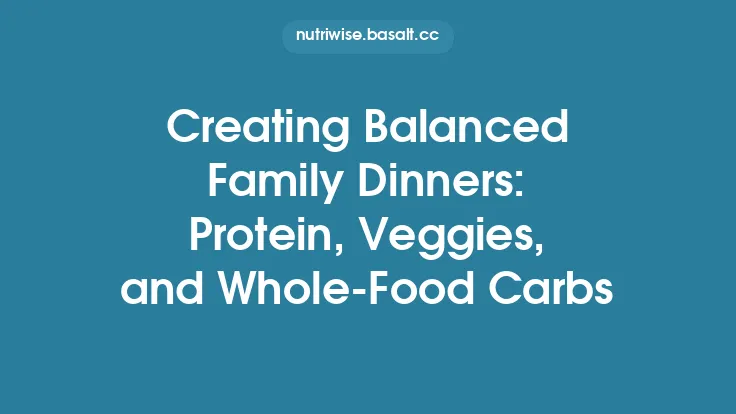Creating satisfying vegan comfort foods is less about chasing the latest food trend and more about returning to the basics: wholesome, minimally processed ingredients that deliver warmth, richness, and a sense of nostalgia. When whole foods become the foundation of a dish, the result is a plate that feels both nourishing and indulgent—exactly what comfort food should be. Below is a deep dive into the principles, techniques, and practical ideas that enable you to craft hearty, plant‑based meals that satisfy the soul without relying on processed shortcuts.
Understanding the Core Elements of Comfort Food
Comfort food is defined less by a specific cuisine and more by a set of sensory expectations:
- Rich Mouthfeel – Creamy sauces, buttery textures, or melt‑in‑your‑mouth softness.
- Robust Flavor – Layers of savory, sweet, salty, and umami that linger.
- Familiar Structure – Casseroles, stews, pies, and baked dishes that evoke home‑cooked memories.
- Warmth – Served hot, often with a side of cozy ambience.
When you translate these expectations into a vegan framework, the challenge is to achieve the same depth using whole, plant‑derived ingredients. The solution lies in strategic ingredient selection, thoughtful cooking methods, and purposeful flavor building.
Selecting Whole Food Ingredients for Maximum Impact
Whole Grains and Starches
- Root Vegetables (potatoes, sweet potatoes, carrots, parsnips) provide natural starches that thicken sauces and create a buttery mouthfeel when roasted or mashed.
- Whole‑Grain Pasta & Rice (farro, barley, brown rice, whole‑wheat noodles) add chew and body, especially when toasted lightly before simmering.
- Squash Varieties (butternut, acorn, kabocha) become silky when puréed, serving as a base for soups and sauces.
Protein‑Rich Whole Foods (Without Focusing on Isolated Sources)
- Beans and Lentils – When cooked until tender, they contribute creaminess to stews and act as a hearty filler in casseroles.
- Mushrooms – Their natural umami and meaty texture make them ideal for “ground” or “shredded” applications.
- Nuts & Seeds (walnuts, pistachios, sunflower seeds) – Ground or blended, they add richness and a subtle crunch.
Flavor Builders
- Aromatics – Onion, garlic, leeks, and shallots form the aromatic base for almost any comfort dish.
- Umami Boosters – Sun‑dried tomatoes, miso (if fermentation is acceptable), nutritional yeast, and roasted seaweed flakes provide depth without animal products.
- Acid & Sweet Balance – A splash of apple cider vinegar, a drizzle of maple syrup, or a handful of dried fruit can brighten heavy dishes.
Fats for Silkiness
- Olive Oil & Avocado Oil – Ideal for sautéing and roasting.
- Coconut Milk (Full‑Fat) – Adds a luscious, creamy texture to curries and soups.
- Tahini – When whisked into sauces, it creates a velvety finish.
Mastering Texture and Mouthfeel
Creaminess Without Dairy
- Cauliflower Purée – Steam cauliflower until fork‑tender, then blend with a splash of plant milk and a knob of olive oil. The result is a low‑calorie, velvety base for mac & cheese or gratins.
- Cashew‑Based Sauces – Soak raw cashews for at least 4 hours, then blend with water, lemon juice, and nutritional yeast. This creates a dairy‑free “cheese” sauce that coats pasta beautifully.
- Silken Tofu – When blended, it yields a smooth, neutral canvas that can be flavored with herbs, spices, and a touch of miso for depth.
Crunch and Crust
- Panko or Ground Oats – Tossed with melted coconut oil and baked, they form a golden crust for baked casseroles.
- Roasted Chickpeas – Lightly seasoned and baked until crisp, they add a satisfying crunch to salads and grain bowls.
- Nuts & Seeds – Toasted almonds or pumpkin seeds sprinkled over soups provide textural contrast.
Chewy and Hearty
- Whole‑Grain Polenta – Cooked slowly with vegetable broth, then baked or fried, it offers a dense, comforting bite.
- Barley or Farro – Their natural chewiness makes them perfect for stews, providing a satisfying bite that mimics the heartiness of meat‑based broths.
Building Depth of Flavor Without Processed Additives
Layered Aromatics
- Sweat the Base – Begin with a low‑heat sauté of onions, carrots, and celery (the classic mirepoix) until translucent. This releases natural sugars and forms a flavor foundation.
- Add Garlic & Spices Early – Introduce garlic, ginger, or fresh herbs after the mirepoix softens; this prevents burning and allows the aromatics to infuse the oil.
Umami Amplification
- Mushroom Duxelles – Finely chop mushrooms, sauté with shallots, and deglaze with a splash of vegetable broth. This concentrated paste can be folded into sauces or layered in pies.
- Roasted Tomato Paste – Roast tomatoes until caramelized, then blend into a thick paste. The natural sugars intensify, delivering a deep, savory note.
- Nutritional Yeast – Sprinkle liberally into sauces, soups, or even mashed potatoes for a cheesy, nutty undertone.
Balancing Sweet, Salty, and Acidic Notes
- Sweet – Caramelized onions, roasted carrots, or a drizzle of maple syrup can offset bitterness from greens or legumes.
- Salty – Sea salt, tamari (a gluten‑free soy sauce), or a pinch of miso adds depth without overwhelming.
- Acid – A splash of lemon juice, apple cider vinegar, or a dollop of tangy fermented (if acceptable) sauerkraut brightens heavy dishes.
Cooking Techniques That Elevate Whole‑Food Comfort Dishes
Roasting for Caramelization
Roasting vegetables at 200 °C (400 °F) for 30–45 minutes develops natural sweetness and a slightly crisp exterior. Toss root vegetables with olive oil, salt, and rosemary before roasting; the resulting caramelized edges become the backbone of a hearty stew.
Braising for Tenderness
Combine sturdy vegetables (e.g., cauliflower florets, sliced mushrooms, carrots) with a flavorful broth, cover, and simmer low and slow. The gentle heat breaks down cell walls, yielding melt‑in‑your‑mouth textures while concentrating flavors.
One‑Pot Casseroles
Layer cooked grains, sautéed aromatics, and a creamy sauce in a deep baking dish. Top with a crunchy oat‑nut mixture and bake until golden. This method minimizes cleanup while allowing flavors to meld.
Slow Cooking
A slow cooker can transform beans, lentils, and root vegetables into a thick, comforting stew. Add a splash of coconut milk toward the end of cooking to prevent curdling and to enrich the final texture.
Sauté‑Finish
For dishes like vegan “mac & cheese,” sauté the cooked pasta briefly in a pan with a cashew‑based sauce, allowing the sauce to cling and develop a slight crust on the edges—adding a delightful contrast.
Sample Recipes Showcasing Whole‑Food Comfort
Below are three fully plant‑based comfort dishes that rely exclusively on whole ingredients. Each recipe demonstrates the principles discussed above.
1. Creamy Cauliflower & Sweet Potato Gratin
Ingredients
- 1 large cauliflower head, cut into florets
- 2 medium sweet potatoes, thinly sliced
- 1 large onion, thinly sliced
- 2 cloves garlic, minced
- 1 cup unsweetened oat milk
- ½ cup full‑fat coconut milk
- ¼ cup nutritional yeast
- 2 tbsp olive oil
- 1 tsp smoked paprika
- Salt & pepper to taste
- ½ cup panko mixed with 2 tbsp melted coconut oil (for topping)
Method
- Preheat oven to 190 °C (375 °F).
- Toss cauliflower florets with olive oil, salt, pepper, and smoked paprika; roast 20 minutes until lightly browned.
- In a saucepan, sauté onion and garlic until translucent. Add oat milk, coconut milk, and nutritional yeast; whisk until smooth. Simmer 5 minutes.
- In a greased baking dish, layer sweet potato slices, roasted cauliflower, and pour over the creamy sauce.
- Sprinkle the panko topping evenly.
- Bake 35–40 minutes, until the top is golden and the sweet potatoes are fork‑tender.
Why It Works
The cauliflower provides body and a subtle nuttiness, while the sweet potatoes contribute natural sweetness and creaminess. Nutritional yeast adds a cheesy note without dairy, and the panko topping offers a satisfying crunch.
2. Hearty Mushroom & Barley Stew
Ingredients
- 1 cup pearl barley, rinsed
- 2 cups mixed mushrooms (cremini, shiitake, portobello), roughly chopped
- 1 large carrot, diced
- 1 celery stalk, diced
- 1 large onion, diced
- 2 cloves garlic, minced
- 4 cups low‑sodium vegetable broth
- 2 tbsp tomato paste (roasted)
- 1 tbsp soy‑tamari
- 1 tsp dried thyme
- 2 tbsp olive oil
- Fresh parsley, chopped (for garnish)
- Salt & pepper to taste
Method
- Heat olive oil in a large pot over medium heat. Add onion, carrot, and celery; sauté until softened, about 5 minutes.
- Stir in garlic and mushrooms; cook until mushrooms release their moisture and begin to brown, 7–8 minutes.
- Add barley, tomato paste, tamari, thyme, and vegetable broth. Bring to a boil, then reduce heat to low and simmer, covered, for 35–40 minutes, or until barley is tender.
- Adjust seasoning with salt and pepper. Serve hot, garnished with fresh parsley.
Why It Works
Barley supplies a chewy, satisfying bite, while the mushroom duxelles deliver deep umami. The slow simmer melds flavors, creating a stew that feels as comforting as any meat‑based version.
3. Vegan “Mac & Cheese” with Cashew‑Pumpkin Sauce
Ingredients
- 300 g whole‑wheat elbow macaroni
- 1 cup raw cashews, soaked 4 hours and drained
- ½ cup pumpkin purée (unsweetened)
- 1 cup unsweetened soy milk
- 2 tbsp nutritional yeast
- 1 tsp Dijon mustard
- ½ tsp smoked paprika
- ¼ tsp ground turmeric (for color)
- 2 tbsp olive oil
- Salt & pepper to taste
- ¼ cup toasted pumpkin seeds (optional garnish)
Method
- Cook pasta according to package directions; drain and set aside.
- In a high‑speed blender, combine soaked cashews, pumpkin purée, soy milk, nutritional yeast, mustard, smoked paprika, turmeric, and a pinch of salt. Blend until ultra‑smooth.
- In a large skillet, heat olive oil over medium heat. Add the sauce and simmer, stirring constantly, until it thickens (about 5 minutes).
- Toss the cooked pasta with the sauce, ensuring each piece is evenly coated.
- Serve warm, topped with toasted pumpkin seeds for added crunch.
Why It Works
Cashews provide a creamy base, while pumpkin adds natural sweetness and a vibrant orange hue. Nutritional yeast supplies the classic “cheesy” flavor, and the toasted seeds introduce a pleasant textural contrast.
Seasonal Variations: Adapting Comfort Dishes Year‑Round
- Winter – Emphasize root vegetables, winter squashes, and hearty grains. Add warming spices like cinnamon, clove, and star anise to soups and stews.
- Spring – Incorporate fresh peas, asparagus, and young greens. Lighten sauces with lemon zest and fresh herbs (mint, dill) while retaining a comforting base.
- Summer – Use grilled corn, zucchini, and tomatoes. Cool the comfort factor with chilled grain salads dressed in a light tahini‑lemon sauce.
- Fall – Celebrate pumpkins, apples, and cranberries. Roast apples with cinnamon and fold into a savory oat‑based crumble topping for pies.
By swapping the core vegetables while keeping the cooking technique constant, you maintain the comforting essence of each dish throughout the year.
Storing and Reheating for Maximum Comfort
- Batch Cooking – Prepare large quantities of grain bases (barley, farro) and roasted vegetables. Store in airtight containers in the refrigerator for up to 5 days.
- Freezing – Soups, stews, and casseroles freeze well. Cool completely, portion into freezer‑safe bags, and label with the date. Reheat gently on the stovetop, adding a splash of broth if the texture has thickened.
- Reheating Tips – To preserve a crispy topping, reheat casseroles uncovered at 180 °C (350 °F) for 15 minutes, or finish under the broiler for the last 2 minutes. For pasta dishes, add a tablespoon of plant milk while reheating to restore creaminess.
Bringing It All Together
Creating vegan comfort foods with whole foods is an exercise in honoring the natural flavors, textures, and nutritional strengths of plants. By focusing on:
- Ingredient integrity – choosing whole, minimally processed produce, grains, nuts, and seeds.
- Layered flavor building – using aromatics, umami boosters, and balanced seasoning.
- Thoughtful techniques – roasting, braising, slow cooking, and strategic finishing.
you can craft dishes that feel indulgent, nourishing, and timeless. The recipes and strategies outlined above provide a flexible framework that can be adapted to any season, palate, or dietary need, ensuring that comfort food remains a staple in a wholesome, plant‑based kitchen.





